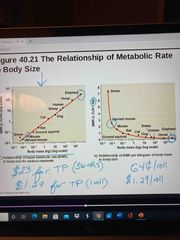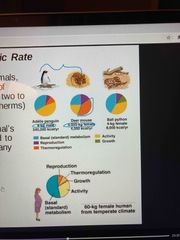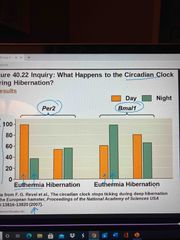![]()
![]()
![]()
Use LEFT and RIGHT arrow keys to navigate between flashcards;
Use UP and DOWN arrow keys to flip the card;
H to show hint;
A reads text to speech;
34 Cards in this Set
- Front
- Back
|
Thermoregulation |
Process by which animals maintain an internal temp within a normal range Involves form, function, and behavior |
|
|
Endothermic |
Animals that generate heat by metabolism (birds and mammals) Can maintain a stable body temp even in face of large fluctuations in environmental temps Is more energetically expensive than ecto |
|
|
Ectothermic |
Animals gain heat from external sources (most invertebrates, fishes,amphibians, and Nonavian reptiles) In general, tolerate greater variation in internal temp |
|
|
Poikilotherm |
Body temp varies with its environment (conformer) Heat source and body temp are not fixed (not all poikilotherms are ectotherms) |
|
|
Homeotherm |
Body temp is constant (regulator) Again..not fixed |
|
|
Balancing heat loss and gain through 4 processes |
1. Radiation 2. Evaporation 3. Convection 4. Conduction |
|
|
Integumentary system |
Skin, hair, nails, horns..items on outside that help in heat regulation |
|
|
5 adaptations that help thermoregulate |
1. Insulation 2. Circulatory 3. Cooling by evaporation 4. Behavioral responses 5. Adjusting metabolic heat production |
|
|
Insulation |
Major thermoregulatory adaptation in mammals and birds Skin, fur, blubber (doesn’t need more food bc of blubber) reduce heat flow btw an animal and it environment (animals stand up their fir to trap heat) Especially important to marine mammals (bc heat travels in water faster) like walruses and whales |
|
|
Circulatory adaptations |
Regulation of blood flow near the surface significantly affects thermoregulation Many endotherms and some ectotherms can alter the amount of blood flowing btw body core and skin Vasodilitaion and vasconstriction (Rabbit and elephant ears) |
|
|
Vasodilation and vasoconstriction |
Vasodilation: blood flow in skin increases, facilitating heat loss Vasoconstriction: blood flow in skin decreases, lowering heat loss |
|
|
Countercurrent system exchange (circulatory adaptation) |
Artery going away from heart and vein going towards the heart are next to each other While artery blood (warmed up) is traveling down to foot, it is giving off heat to the vein that has cooler blood, thus warming the blood going back to the heart (which is almost completely warm) This does not warm the foot bc the artery blood is losing heat as it goes down. Some Sharks, fishes and insects use this |
|
|
Coping by evaporation |
Many types of animals lose heat through evaporation of water from their skin Sweating or bathing moistens the skin, helping to cool and animal down Panting increases the cooling effect in birds and many mammals |
|
|
Behavioral responses |
Ectotherms (endotherms at times) use behavior to control temp They seek warm places when cold and orient themselves toward heat sources When hot they bathe or move to cooler areas to change orientation ie: dragonfly orients body to avoid heat, bees huddle for heat and bring water in to cool hive |
|
|
Adjusting metabolic heat |
Thermogenesis: increased muscle activity such as moving and shivering Birds and some reptiles raise body temp by shivering (chickadees shiver themselves warm in -40 degrees) Nonshivering thermogenesis: when hormones cause mitochondria to increase their metabolic activity instead of creating ATP |
|
|
Brown fat |
Mammals have tissue that is designed for rapid heat production It is found in infant mammals and hibernating mammals Amount of brown fat in adults has been found to vary on temp of environment |
|
|
Acclimatization in thermogenesis |
Bird and mammals can vary their insulation to seasonal temps Lipid composition of cell membranes may change with temps Some cells Allan produce enzymes (like antifreeze) that can prevent freezing in cells |
|
|
Hypothalamus |
Thermostat for the body Triggers heat loss or heat generating mechanisms (shivering or blood vessel change) |
|
|
Fever |
Increase in normal range for bio thermostat Change in set point to kill infection Ectotherms actually seek higher temps to heat body more to kill infection |
|
|
Bioenergetics |
Overall flow and transformation of energy in an animal It determines an animals nutritional needs and it relates to the size activity and environment of the animal |
|
|
Energy allocation and use |
Organisms can be classified by how they obtain chemical energy Autotroph: plants, harness light energy to build molecules Heterotrophs: animals, harvest chemical energy from food |
|
|
Biosynthesis |
After needs ofbstaying alive are met, remaining food molecules are used in biosynthesis Growth and repair Synthesis of Storage of material such as fat Production of gametes |
|
|
Metabolic rate |
Sum of all the energy an animals used in a unit of time |
|
|
Determine metabolic rate by... |
Animals heat loss Amount of oxygen or carbon dioxide produced Measuring energy content of food consumed and energy lost in waste products |
|
|
Basal metabolic rate va standard metabolic rate |
Basal: Metabolic rate of an endotherm at rest at a comfortable temp Standard: rate of an ectotherm at rest at a specific temp Both rates assume a nongrowing, fasting, and nonstressed animal Ectotherms have lower rates than endotherms of a comparable size (BMR for humans is 1300-1800 kcal/day, but SMR for an alligator is 60 kcal/day at 20•C |
|
|
Influences on metabolic rate |
Age, sex, size, activity, temp, and nutrition |
|
|
Size and metabolic rate |
Proportional to the body mass to the power of 3 quarters (m^3/4) Smaller animals have a higher metabolic rate per gram than larger animals (need more oxygen, faster heart rate, more blood volume as compared with a larger animal) ie: each gram of a mouse has 20x calories than a gram of an elephant |
|
|
TP analogy with metabolic rate |

D |
|
|
For most terrestrial animals..rate of consumption |

Average daily rate of energy consumption is 2 to 4 times BMR or SMR Fractions of an animals energy budget devoted to activity depends on: Environment, behavior, size, mechanism of thermoregulation ie: compare penguin and python. Penguin has red pie devoted to thermoregulation but python does not. The little mouse devotes a lot more to thermoregulation even though it is smaller |
|
|
Torpor |
Physiological state of decreased activity and metabolism Enables animals to save energy while avoiding difficult and dangerous conditions (severe conditions) hibernation is long term torpor that is an adaptation to winter cold and food scarcity |
|
|
Hibernation |
Can be 20 times lower than if an animal tried to keep normal temp Molecular components of bio clock stop oscillating |
|
|
Estivation |
Summer torpor Enables animals to survive long periods of high temps and scarce water Daily torpor is exhibited by many small animals |
|
|
Circadian clock and hibernation |

Looking at 2 genes associated with day and night cycles Levels of per2 are high during the day and goes down at night Levels of bmal as wel |
|
|
Remember |
Structure function relationships Fundamental similarities in evolution |

